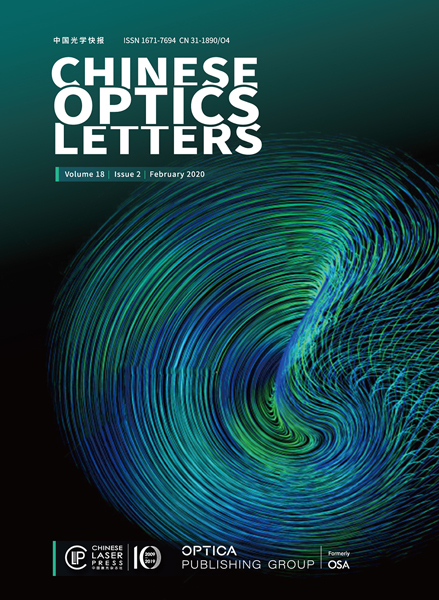 View fulltext
View fulltext
An ultraviolet (UV) Raman lidar system at 354.7 nm has been developed for accurately measuring the aerosol extinction profiles. A spectroscopic filter combining a high-spectral-resolution grating with two narrowband mirrors is used to separate the vibrational Raman scattering signal of N2 at a central wavelength of 386.7 nm and the elastic scattering signal at 354.7 nm. The aerosol extinction is derived from the Raman scattering of N2 and the elastic scattering by the use of Raman method and Klett method, respectively. The derived results of aerosol extinction are used to compare the difference of two retrieval methods, and the preliminary experiment shows that the Raman lidar system operated in analog detection mode has the capability of measuring aerosol profiles up to a height of 3 km with a laser energy of 250 mJ and an integration time of 8 min.
The performance of normalized throughput in wavelength division multiplexing (WDM) based coherent time-spreading optical code division multiple access (TS-OCDMA) system is studied. The upper bound and lower bound of normalized throughput are obtained with 8 wavelength channels and 127-length Gold code, and with 4 wavelength channels and 511-length Gold code respectively. It is shown that when all simultaneous users are equally allocated to different wavelength channels, WDM+TS-OCDMA has much better performance. However, if there is no central control to allocate wavelength channels equally, WDM+TS-OCDMA system has the in-between performance of normalized throughput.
A new generation algorithm of two-dimensional triple-codeweight asymmetric optical orthogonal codes for optical code division multiple access (OCDMA) networks is proposed. The code cardinality is obtained and the error-probability performance for corresponding OCDMA system is analyzed. The codes with two constraints (i.e., auto- and cross-correlation properties) being unequal are taken into account. On the premise of fixed system resources, the code cardinality can be significantly improved. By analysis of the error-probability performance, it is shown that the codes with different parameters have different performances. Therefore, this type of codes can be applied to support diverse quality of service (QoS) and satisfy the quality requirement of different multimedia or distinct users, and simultaneously make the better use of bandwidth resources in optical networks.
The diffractive beam parameters of LP01 mode of fiber are analyzed in detail. Based on solving linear equations, two formulas for two kinds of mode-field radii as functions of normalized frequency are presented, and relations between angular radius of far-field divergence, beam propagation factor, and normalized frequency are given. Numerical calculation indicates that the maximal relative error is smaller than 1% within a reasonable parameter range.
We propose a 40-Gb/s star 16-ary quadrature amplitude modulation (16-QAM) transmitter using a single dual-drive Mach-Zehnder modulator (DDMZM). This transmitter is demonstrated through experiment and simulation and shows the advantage of simplicity for implementation. Simulation results indicate that error free performance could be achieved for the generated signal after 80-km standard single-mode fiber (SSMF) transmission with coherent detection scheme.
A full experimental characterization of mechanically induced long-period fiber gratings (MLPFGs) fabricated by pressing a plate with periodic grooves against a short length of fiber is presented. This technique enables a good control over the gratings’ isolation loss peaks and has high repeatability. The spectra characteristics of MLPFGs are studied with the change of the parameters including pressure, period, and temperature. The produced MLPFGs have low insertion loss (<0.2 dB) and the loss peaks can be higher than 20 dB. A large tunability of the resonant wavelength (>14 nm) is achieved through adjusting pressure grooves’ period. The center wavelength temperature sensitivities of 0.057, 0.086 nm/oC, and resonant peak temperature sensitivities of 0.230, 0.312 dB/oC, are achieved for jacketed and unjacketed fibers, respectively. These MLPFGs, which are simple and inexpensive, also offer the unique advantages of being tunable, erasable, and reconfigurable.
We present a method for metal coating optical fiber and in-fiber Bragg grating. The technology process which is based on electroless plating and electroplating method is described in detail. The fiber is firstly coated with a thin copper or nickel plate with electroless plating method. Then, a thicker nickel plate is coated on the surface of the conductive layer. Under the optimum conditions, the surfaces of chemical plating and electroplating coatings are all smooth and compact. There is no visible defect found in the cross-section. Using this two-step metallization method, the in-fiber Bragg grating can be well protected and its thermal sensitivity can be enhanced. After the metallization process, the fiber sensor is successfully embedded in the 42CrMo steel by brazing method. Thus a smart metal structure is achieved. The embedding results show that the plating method for metallization protection of in-fiber Bragg grating is effective.
We demonstrate a 7-bit photonic true-time-delay (TTD) system which uses an 8\times8 micro-optical-electro-mechanical system (MOEMS) optical switch for phased array antennas (PAAs) beamforming applications. The switch controls the optical signal to pass by the fiber delay lines (FDLs) of different lengths. Different time delays between adjacent channels are obtained due to the chromatic dispersion of FDLs. Therefore, the system cannot be disturbed by the environment. The measured time delay responses are nearly linear with the wavelength spacing between optical carriers as well as the lengths of FDLs, which agrees well with the theoretical analysis.
At cryogenic temperature, a fiber Bragg grating (FBG) temperature sensor with controllable sensitivity and variable measurement range is demonstrated by using bimetal configuration. In experiments, sensitivities of -51.2, -86.4, and -520 pm/K are achieved by varying the lengths of the metals. Measurement ranges of 293-290.5, 283-280.5, and 259-256.5 K are achieved by shortening the distance of the gap among the metals.
Laser-diode pumped Q-switched ytterbium-doped fiber laser is studied experimentally by controlling the switching time of acousto-optic modulator (AOM). The characteristics of Q-switched pulses with different rise time of AOM regulated by the laser beam size along the window of AOM are presented. Meanwhile, the behaviors of Q-switched pulses are achieved by regulating the switching time of AOM. The single-repetition-rate and half-repetition-rate phenomena are described and discussed. The experimental results confirm that the fiber laser with lower level inversion population can be more easily operated for half-repetition-rate generation.
Optically pumped terahertz (THz) lasers with high pulse repetition frequency are designed. Such a laser includes two parts: the optically pumping laser and the THz laser. The structures of the laser are described and analyzed. The rate equations for the pulsed THz laser are given. The kinetic process and laser pulse waveform for this kind of laser are numerically calculated based on the theory of rate equations. The theoretical results give a helpful guide to the research of such lasers.
A novel post-treatment method, including hard hairbrush and electrical treatment, is performed intentionally to improve the field emission capability and stability of screen-printed carbon nanotubes (CNTs). Compared with untreated films, the field emission properties of the treated ones are greatly enhanced. Scanning electron microscopy (SEM) and Raman spectrum studies reveal that field emission properties are enhanced by two factors. Firstly, the improved field emission properties of CNT films can be attributed to the more active CNT surface by removing the organic material cover on the CNTs. Secondly, the generation of a high density of structural defects and the lower resistance contact to the topside CNT emitters after treatment are all helpful to improving the field emission properties of the treated CNTs.
The imaging system formed by an annular left-handed material (LHM) lens as well as the evanescent waves in the lens are simulated numerically with a finite-difference time-domain (FDTD) method. For b-a>\lambda (a and b are respectively the inner and outer radii of the annular lens, and \lambda is the wavelength), when a point source is placed at an internal grid point, we demonstrate that the evanescent waves are produced around the internal interface, and cannot propagate outwards. As for b-a<\lambda, the evanescent waves appear around both the internal and the external interfaces, which remarkably implies the coupling between the two interfaces. Hence it can be inferred that the evanescent waves around the external interface participating in the super-resolution imaging result from the coupling of the evanescent waves around the interface. Moreover, the partly uncomprehended properties of the evanescent waves in the LHM slab are also disclosed. It is conducive to understanding the evanescent waves in the LHMs further.
The influence of scanning speed on hard bone tissue ablation is studied with a 10.6-\mum laser. The groove morphology and the thermal damage created in bovine shank bone by pulsed CO2 laser are examined as a function of incident fluence by optical microscope following standard histological processing. The results show that ablation groove width, depth and ablation volume, as well as the zone of thermal injury, increase gradually with incident fluence. As compared to the result for high scanning speed, the lower scanning speed always produces larger ablation volume but thicker zone of thermal injury. It is evident that scanning speed plays an important role in the ablation process. In clinical applications, it is important to select appropriate scanning speed to obtain both high ablation rates and minimal thermal injury.
A new method is proposed for the object surveillance system based on the enhanced fish-eye lens and the high speed digital signal processor (DSP). The improved fish-eye lens images an ellipse picture on the charge-coupled device (CCD) surface, which increases both the utilization rate of the 4:3 rectangular CCD and the imaging resolution, and remains the view angle of 183 degree. The algorithm of auto-adapted renewal background subtraction (ARBS) is also explored to extract the object from the monitoring image. The experimental result shows that the ARBS algorithm has high anti-jamming ability and high resolution, leading to excellent object detecting ability from the enhanced elliptical fish-eye image under varies environments. This system has potential applications in different security monitoring fields due to its wide monitoring space, simple structure, working stability, and reliability.
A novel grating light modulator for projection display is introduced. It consists of an upper moveable grating, a bottom mirror, and four supporting posts between them. The moveable grating and the bottom mirror compose a phase grating whose phase difference is controlled by the actuating voltage. When the phase difference is 2k\pi, the grating light modulator will switch the incident light to zero-order diffraction; when the phase difference is (2k-1)\pi, the grating light modulator will diffract light to first-order diffraction. A 16\times16 modulator array is fabricated by the surface micromachining technology. The device works well when it is actuated by a voltage with 1-kHz frequency and 10-V amplitude. The fabricated grating light modulator can show blackness and brightness when controlled by the voltage. This modulator has potential applications in projection display system.
Light emitted by an atomic source of radiation appears to travel along a straight line (ray) from the location of the source to the observer in the far field. However, when the energy flow pattern of the radiation is resolved with an accuracy better than an optical wavelength, it turns out that the field lines are usually curved. We consider electric dipole radiation, a prime example of which is the radiation emitted by an atom during an electronic transition, and we show that the field lines of energy flow are in general curves. Near the location of the dipole, the field lines exhibit a vortex structure, and in the far field they approach a straight line. The spatial extension of the vortex in the optical near field is of nanoscale dimension. Due to the rotation of the field lines near the source, the asymptotic limit of a field line is not exactly in the radially outward direction and as a consequence, the image in the far field is slightly shifted. This sub-wavelength displacement of the image of the source should be amenable to experimental observation with contemporary nanoscale-precision techniques.
2 Based on quantum mechanics, a traveling ballot scheme with anonymity and secrecy is introduced to realize voting. By searching the objects in large amount of data bases, every voter may cast votes to his desired candidates. Therefore, the proposed scheme may be applied to voting with a great deal of candidates, such as network voting and so on. The security analysis of the present scheme is also performed.
Through the use of time and space integrated kiloelectronvolt (keV) spectroscopy, we investigate the thermal emission of plasma, which produces strong line emission from the titanium K shell (He-\alpha at 4.7 keV and H-alpha at 4.9 keV), created by laser. In order to optimize the conversion efficiency enhancement on titanium foils, the experiment is conducted under a variety of laser-driven intensity conditions. The X-ray emission intensity at 4.7 keV is measured and compared with prediction. The experimental result demonstrates that the solid Ti target laser-produced plasma (LPP) source has X-ray emission at 4.7 keV, which are all generated from electronic transitions in Ti ions at pulse width of 2.1 ns or 30 ps, the crudely evaluated He-\alpha X-ray intensity appears to slightly increase with laser intensity enhancement, and the pre-pulse effect increases the conversion efficiency of the He-\alpha X-ray. In addition, a 90-\mum-thick Ti foil as a filter is used to transmit He-\alpha X-ray at near 4.7 keV, creating a quasi-monochromatic transmission and greatly reducing the lower- and higher-energy background.
The ultraviolet (UV) light excited fluorescence spectra of ethanol-water mixture with different concentrations are investigated by derivative fluorimetry. It is found that there are 8 types of luminescent cluster molecules, formed by ethanol and water molecules in different ways, existing in the solution. The peak wavelengths of all these clusters’ fluorescence spectra are measured and their contents are obtained by measuring the peak values in the second derivative fluorescence spectra. The spectra corresponding to the 8 types of clusters are obtained by Gaussian decomposition. It is found that two kinds of cluster molecules whose peak wavelengths are 330 and 345 nm have an optimal excitation wavelength located at (236+-3) nm. This research contributes to the study of ethanol-water cluster structures and their physical and chemical characteristics.
Four kinds of Y2O3 stabilized ZrO2 (YSZ) thin films with different Y2O3 contents (from 0 to 12 mol%) are deposited on BK7 glass substrates by electron-beam evaporation method. The effects of different Y2O3 dopant contents on residual stress, structure, and optical properties of ZrO2 thin films are investigated. The results show that residual stress in YSZ thin films varies from tensile to compressive with the increase of Y2O3 molar content. The addition of Y2O3 is beneficial to the crystallization of YSZ thin film and transformation from amorphous to high temperature phase, and the refractive index decreases with the increase of Y2O3 molar content. Moreover, the variations of residual stress and the shifts of refractive index correspond to the evolution of structures induced by the addition of Y2O3.
Two-photon photopolymerization (TPP) with femtosecond laser is a promising method to fabricate three-dimensional (3D) photonic crystals (PCs). Based on the TPP principle, the micro-fabrication system has been built. The 3D woodpile PCs with rod space of 2000 nm are fabricated easily and different defects are introduced in order to form the cross-waveguide and the micro-laser structure PCs. Simulation results of the optical field intensity distributions using finite-difference time domain (FDTD) method are given, which support the designs and implementation of the PC of two types in theory.
We propose that domain inversion can be directly induced by femtosecond laser both theoretically and experimentally, which opens a path to achieve three-dimensional (3D) nonlinear crystal with a period in sub-micron-scale. A simulation of domain inversion is modeled by considering the temporal distribution of femtosecond pulses. The calculation results clarify that the domain inversions can happen within or after the interaction with the laser pulse, and the response time of domain inversion is in the picosecond level depending on the intensity and the materials. The domain reversal windows of lithium niobate by femtosecond laser are observed which agrees with theoretical predictions qualitatively.










